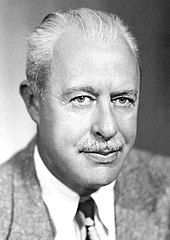Walter Houser Brattain
Walter Houser Brattain (born February 10, 1902 in Amoy , German Empire , † October 13, 1987 in Seattle , Washington ) was an American physicist and Nobel Prize winner .
Life

Walter Brattain was born to Ross R. Brattain and Ottilie Houser in Amoy (now Xiamen), China. He grew up in Washington State and received his BS from Whitman College in 1924 and an MA from the University of Oregon in 1926 . In 1928/29 he was a physicist at the National Bureau of Standards . After receiving his doctorate in 1929 at the University of Minnesota , he moved to Bell Laboratories , where he retired in 1967.
During the Second World War , he conducted research at Columbia University from 1941 to 1943 . From 1967 to 1972 he was visiting professor at Whitman College and 1951/52 at Harvard University . From 1960 to 1966 he was on the Naval Research Advisory Committee of the US Navy and from 1966 to 1968 at the Naval Ordnance Test Station.
Brattain married Dr. Keren (Gilmore) Brattain, with whom he had a son (William Gilmore Brattain), and in 1958 Emma Jane (Kirsch) Miller.
plant
Brattain mainly dealt with the surface properties of solids. After initial investigations into tungsten , he was primarily interested in surface effects in semiconductors such as silicon and germanium , to whose better understanding he made important contributions. Together with John Bardeen he developed the point contact transistor .
Brattain received the Nobel Prize in Physics in 1956 together with William B. Shockley and John Bardeen "for their research on semiconductors and their discovery of the transistor effect ".
Awards
- Stuart Ballantine Medal, Franklin Institute, 1952
- John Scott Medal , 1955
- Nobel Prize in Physics , 1956
- Member of the American Academy of Arts and Sciences , 1956
- Member of the National Academy of Sciences , 1959
Web links
- Information from the Nobel Foundation on the 1956 award ceremony for Walter H. Brattain (English)
- Walter H. Brattain. In: Physics History Network. American Institute of Physics
| personal data | |
|---|---|
| SURNAME | Brattain, Walter Houser |
| BRIEF DESCRIPTION | American physicist and Nobel Prize winner |
| DATE OF BIRTH | February 10, 1902 |
| PLACE OF BIRTH | Amoy , Chinese Empire |
| DATE OF DEATH | October 13, 1987 |
| Place of death | Seattle , Washington |
